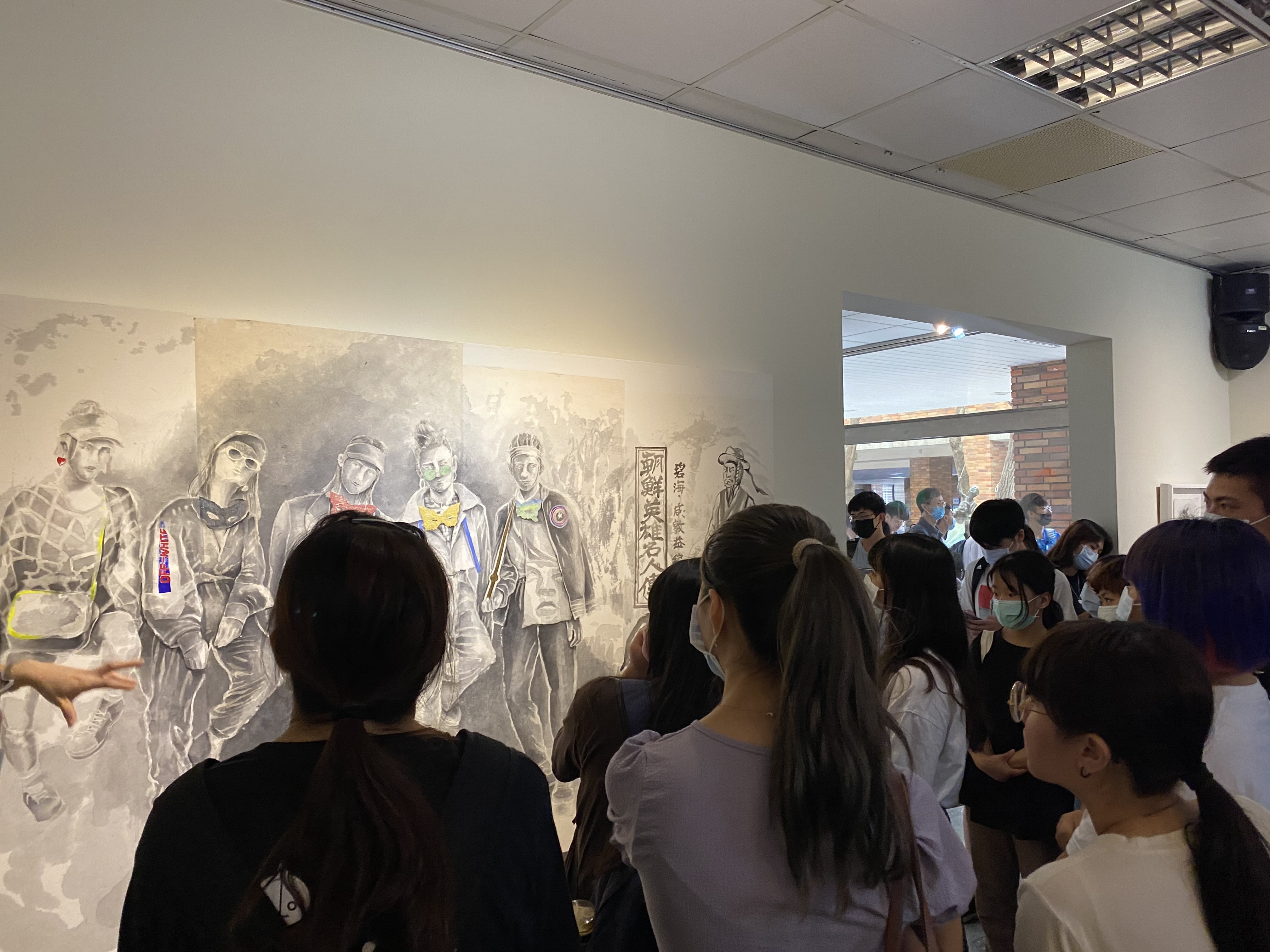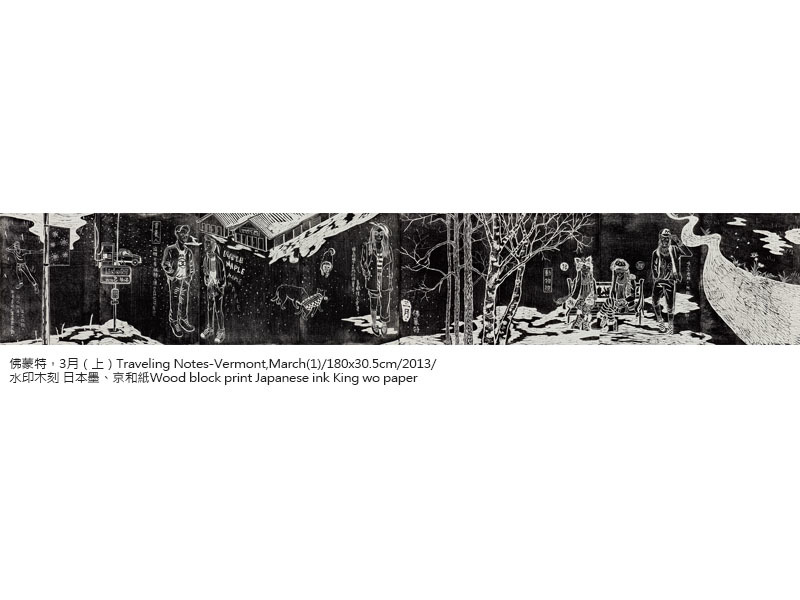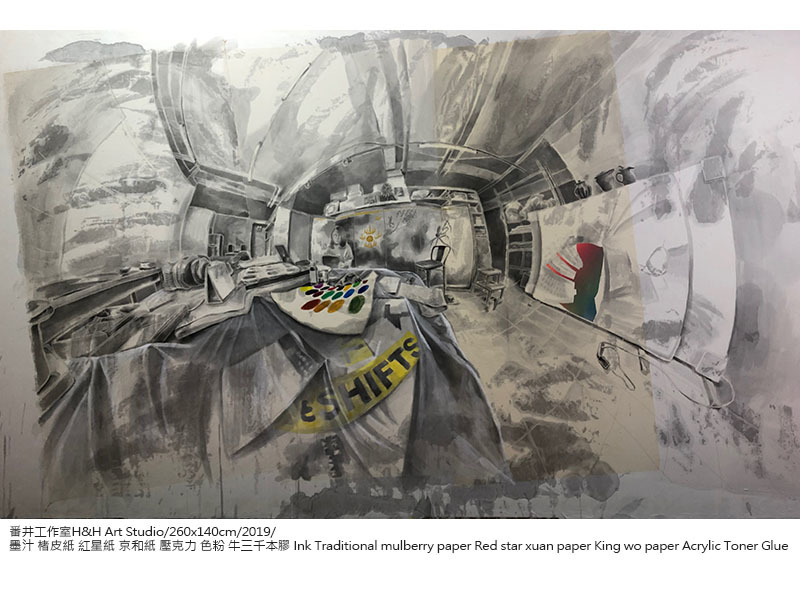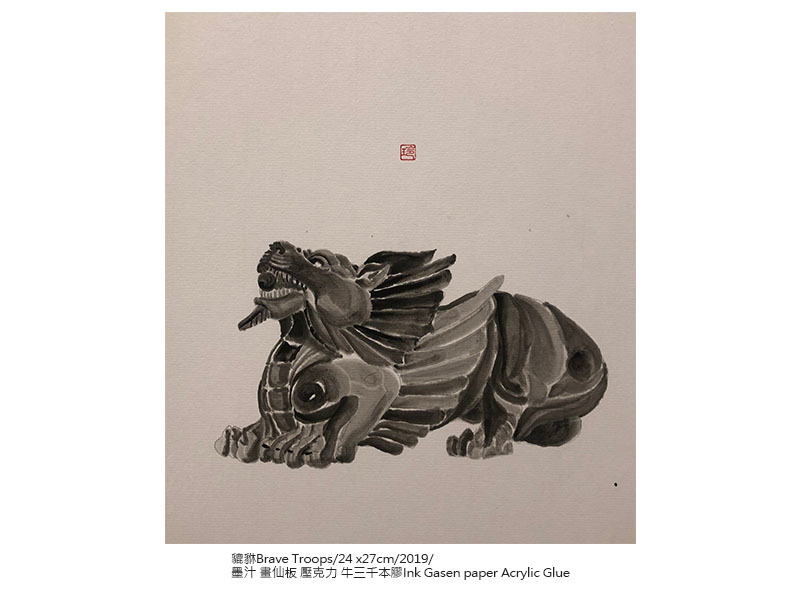
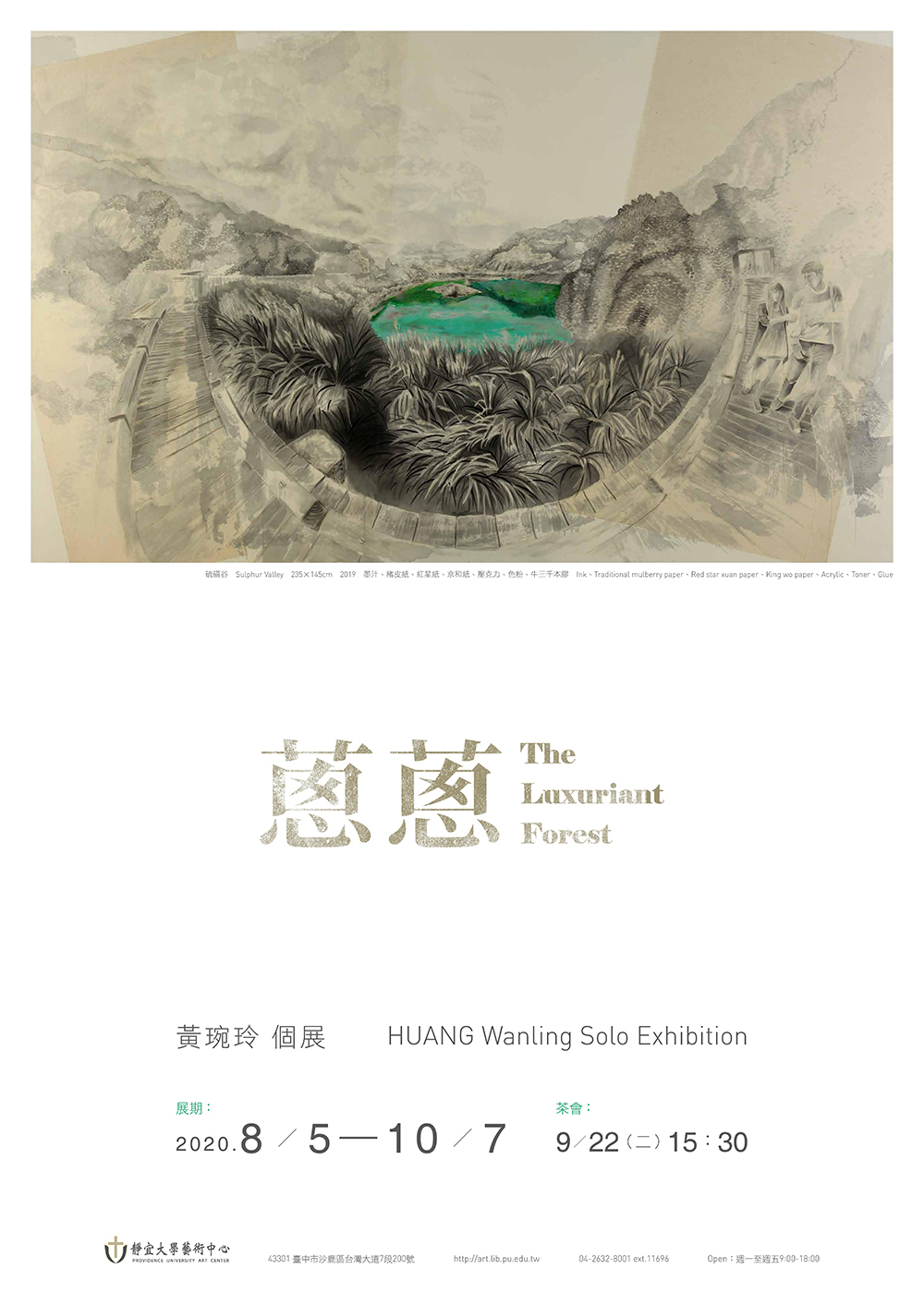
蔥蔥-黃琬玲個展
黃琬玲成長於消費文化快速擴張的年代,人們藉由獨特的消費品味與活動,塑造自己的身分與認同。大學就讀於版畫組,以此現象為發想,創造以水墨為材質詮釋影像與版畫的方法,製作出具有負片效果的系列作品——《貢養人》,雜揉傳統水墨、流行符號語彙與鮮艷的顏料色彩,發展出獨特的創作語彙。2013年,工作室的一場大火,吞噬過往累積的一切,但也點燃了重新面對自己與自己對話的道路,創作轉向觀看自身,選擇以水印木刻的窄長卷畫創作《遊記》系列,對傳統材質與水墨有更深刻的掌握。《遊記》紀錄著生活的片段,將記憶集結為有敘事性的故事,其創作從圖像拓展至具敘事性的表現。
近期發展的《名所繪》系列以放射狀的透視點構成具有擴延性的視覺,向外擴散的構圖方式,形成沒有消失點的風景繪畫,以此呼應多點透視的文人繪畫,提出對風景繪畫的再思考。黃以膠描繪線條結構,再使用破碎、殘影、拓踏的方式,重新構築繪畫圖像與空間,混沌濕潤的筆觸與影像的層層堆疊,繪出一幅幅空氣、濕度流轉於紙上的場景。如同作品中展現的瞬息被畫筆勾勒成凝結的記憶,地景物件將隨著時間更迭嬗變,但在土地上孕育而生的文化卻能夠透過傳承而續存。
「蔥蔥」草木蒼翠茂盛的樣子,象徵著這片土地豐沛的生命能量以及爆發的文化狀態,也是黃琬玲腦海中靈感的縮影,美好而蓬勃。漫步在開放與直觀之間,不囿限於媒材的屬性與歷史,也不固著於技巧的雕琢,伴隨著自己的生命經驗,黃琬玲希望能劃開了一條路徑,探尋平面繪畫如何重新創造不可取代的生命力。
從制高處回望與前瞻——記黃琬玲靜宜個展
Looking Back While Gazing Ahead From a High Vantage Point–
HUANG Wanling Solo Art Exhibition Notes
文\靜宜大學藝術中心主任 彭宇薰
by Yushun Elisa Pong, Director of Art Center, Providence University
必須冒險,注定叛逆,天生特立獨行——黃琬玲藝術創作之途,雖顛簸坎坷,卻始終如一。從二十幾歲初出道的《貢養人》水墨系列開始,她就以其獨特的「生猛氣質」昭告一己獨特的存在性;後來以風景為主題的《遊記》版畫系列,乃至最近的《名所繪》水墨系列,則可見其在生活、歲月的淬煉下,與藝術創作本身的自我對話,並披露其拓展格局與深化省思的發展軌跡。我們很高興在琬玲近四十而不惑之際,為她的藝術事業留下一個重要的見證。
As a rebel with a constant craving for adventure, Wanling Huang’s career in art may have been rough and bumpy, yet it has always remained consistent with her individualistic tendencies. Starting with her debut series of ink paintings titled, Gong Yang Ren, in her early twenties, she has been proclaiming her unique existence with a distinctly fierce temperament. Her later scenery-based print series, Traveing Notes, and more recent Meisho-E ink paintings serve as examples of her dialogue with art crystallized by life experience and the passing of time. The works also reveal traces of development in framework expansion and intense self-reflection. We are happy to bear witness to her artistic career as she approaches 40, an age without ambiguity.
生命能量的觀點來看,琬玲是一個強大的變動不居能量之承載體,她既具有敏銳的直覺性,也擁有極高的願景。由於其火能量非常旺盛,故早期的作品外向粗放,這種向上飛揚、盡情揮霍的年少青春,以及不多加修飾的「魯莽」直接性,終需要放慢沉澱,化為更富內聚力的曄然華光。這些年來,琬玲隨著生命能量的調整,遊走在版畫與水墨之間:版畫雖然耗時費工,然正好內斂其烈焰,收束其心志,但真正說來,她更需要一種處於制高點的宇宙性視野探勘與揮灑,因此具備高度自由性、一落筆即無可回顧的水墨創作,終究成為其理想的大格局作品之表現媒材。然而,大格局所需的深厚內涵,才是隨之而來必不可免的卓絕挑戰,這是琬玲生命必然要面對的另一波浴火鳳凰的戰鬥。
From the perspective of life, Wanling is a powerful conveyor of ever changing energy, employing a keen intuition along with an exceedingly grand vision. She has so much fiery passion that her earlier works can be considered exuberant and unrefined. This type of high-flying, audacious sense of youthfulness and unpolished, reckless straightforwardness all settle down eventually to transform into a cohesive brilliance. Over the years, Wanling has transitioned between print-making and ink painting as life energies realign themselves. Print-making is time-consuming and labor-intensive, but it is also the perfect tool to restrain her passion and rein in her aspirations. Realistically speaking, she needs a universal visual exploration and expression from a commanding vantage point. Thus, ink painting, which offers a high degree of freedom and the characteristic of “no going back” once the pen is engaged on paper, serves as the perfect medium for her ideal large-scale works. However, the solid inner qualities required by large-scale works are unavoidable challenges of excellence faced by Wanling in yet another wave in her crucible.
爰此,琬玲的社會關照從早先的次文化現象,轉向更為廣泛的多元文化比較與觀察。晚近以來,她在美國、韓國、日本等地的藝術駐村經驗,毫無疑問帶來了豐富的滋養,並刺激她對於本土的傳統文化,別有意識地再進一步思考與領會。琬玲宛若一位拓荒者,試圖潛入人類集體潛意識中,挖掘出殘渣或寶物,創意性地指向未來;她需要階段性地沈潛在直覺與理性思考中,消化她在世俗或神話世界裡,接收各種或可名、或不可名的訊息,並與自己強烈的能量對話。從現階段的成果來看,她的新視野與世界觀已然成形,無論其用了什麼新穎的技法和語彙,琬玲永遠是琬玲,其風格別無分號,獨一無二!
In light of this, Wanling’s social concerns have transitioned from the earlier sub-cultural phenomenon to an expansive and diversified comparison and observation of culture. Recently, her art residency in the U.S., South Korea, and Japan have brought her plenty of nourishment, stimulating her conscious contemplation and understanding of traditional local culture. Wanling is like a pioneer attempting to sneak into the human collective subconsciousness to excavate relics or treasure, while creatively pointing towards the future. She requires staged immersion in intuition and rational contemplation to digest various named or unnamed messages in the ordinary or mythical world, and to engage in a dialogue with her strong life energy. Judging by her current achievements, a brand new perspective and worldview have apparently taken shape. Regardless of the innovative techniques and vocabularies she uses, Wanling will always be Wanling. Her style is truly unique!
為崛起的藝術家歡呼與祝賀!謹此,是以為序。
Cheers to this up and coming artist! Congratulations! With all sincerity, let this serve as the preface to the exhibit.
在大稻埕的風景背後:
黃琬玲「名所繪」中關於透視法與
地方想像的時代語彙
Behind the Landscape of Dadaocheng:
Language of the Time on Perspective and Local Imaginations in HUANG Wanling’s Meisho-E
文\陳飛豪
Chen Fei-hao
1968年4月在日本開幕,後來被認為預示且開啟「物派」的展覽「Tricks and Vision」中,策展人石子順造與中原佑介將透視法視為西方藝術系統進入亞洲世界後的一個衝擊想像:即在視覺上透過這樣近似於「Trick」的繪畫技巧改變了日本(或者說東亞各國)既有的傳統繪畫系統,造成一股夾雜著「文明開化」歷史意涵的全新創作風潮之後,日本藝術界要如何開啟下個時代階段的「Vision」(眼界),則是後進的創作者們必須思考與探索的新目標,而這似乎也可以指涉到藝術史東西方繪畫中,特別是現代化西方風潮強勢介入亞洲世界後,「多點透視」與「單點透視」彼此交錯的發展進程。
Opened in Japan in April of 1968, the “Tricks and Vision” exhibition would be later regarded as a foreshadow of Japan’s Mono-ha style. The curators, Ishizo Junzo and Yusuke Nakahara, considered perspective to be a jolt on the imagination after Western art composition established a foothold in Asia. Through a shift in visual perception introduced by techniques similar to those employed in Trick, it changed the existing traditional painting system of Japan (or, of all East Asian countries). The result was the formation of an entirely new creative trend imbued with the historical significance of “civilization and revelation”. How Japanese art would launch the next era’s “Vision” would serve as the latest goal of contemplation and exploration by artists to come. This also seemed to refer to the intertwining development process of multi-point perspective vs. one-point perspective in eastern and western paintings in art history, especially after modern western trends strongly intervened in the Asian world.
這類對於透視法的想像與思考,在2020年的台灣,藝術家黃琬玲則是在她最新以水墨為主要媒材的創作系列「名所繪」當中,試著透過攝影語彙,特別是魚眼、廣角的影像特質:即圓形構圖存在於影像中間的消失點,或者是環景影像中,存在於畫框外的消失點,顛覆原本東西方不同的透視想像,並將東方特有的水墨媒材結合這類近似於超寫實主義的機械性語彙。但有趣的是,她最終則是選擇將畫作中經營的一切,回應至東方特有的「名所繪」主題,也展現出藝術家針對現今台灣景點名勝的文化觀察,與其和自身生活經驗的重要連結,而黃琬玲也詮釋出台灣歷史與時代的更迭,如何影響並轉換了地面上的建築、物件、裝飾物與風景,而這也是這塊土地,在政權轉換之下顯露出的,既斷裂,卻又弔詭融合的文化風景。
In 2020 in Taiwan, for this type of imagination and contemplation regarding perspective, artist Huang Wanling presented her latest Meisho-E series using ink as the main medium, employing photographic elements, such as fisheye and wide-angle image qualities. Her circular composition either existed in the vanishing point within the image, or the surrounding image existed in the vanishing point outside of the picture frame. Her technique not only subverted the perspective of imagination originally different in the east and west, but also combined the ink medium unique in the east with this type of mechanical vocabulary similar to hyperrealism.
What is captivating is her final choice, which arranged the painting in response to the theme of Meisho-E unique to the east. Her works also demonstrated an artist’s cultural observation of scenic locations in modern Taiwan and the important connections with her own life experience. In addition to showcasing Taiwan’s history and the changing times as well as the resulting impact and transformation of architecture, objects, decoration and scenery, Huang Wanling also interpreted how the land revealed a paradoxically torn yet cohesive cultural landscape through changes in political regimes.
藝術史中,日治時期台灣藝術家們爭相繪製,具有彰顯「地方色」意涵,以及台灣風景主題的繪畫創作,雖然政治結構上帶有殖民者將其納入日本美術支脈的意圖,但事實上更值得注意的是台灣畫家們從中得到的現代性經驗與文明開化後胸懷世界的想望。其中許武勇,就是眾多前輩藝術家中令筆者印象深刻的一位。身為少數受教於鹽月桃甫的台灣人畫家,他也謹從鹽月的指導,不要特意模仿自己的老師,應自在地追尋屬於自己的藝術想望。也因此,許武勇在行醫之餘,也遨遊於自身建構的立體主義世界與幾何性的視覺想像。在作品當中,他接續了日治時期「地方色」風潮的歷史情緒,將台灣的各種風景入畫,大稻埕的街屋與廟會遊行、台南普濟殿、花園町與台南車站前的戰後街景,都在他的筆下展現出如夢般虛實交錯的奇幻場景。
During the period of Japanese rule, artists in Taiwan rushed to create works with “local colors” centered around Taiwan’s landscapes. Though it was also a political attempt by the colonizers to incorporate such works into Japanese art, it is even more important to note that Taiwanese artists obtained modern experience and a worldview from this period. Among them, Hsu Wu-yung was one of the many impressive artists.
As one of the few Taiwanese painters who studied under Sogetsu Momo, he strictly followed guidance not to imitate his teacher, but focus on exploring his own artistic vision. As a result, in his spare time after practicing medicine, Hsu pursued visual imaginations in his own creation of a cubist and geometric world. In addition, he continued the historical sentiment of “local colors” during the period of Japanese rule by painting a fantasy life that interlaced dreams and reality while incorporating various landscapes of Taiwan, such as the houses and temple fairs in Dadaocheng, Puji Temple and Hanazono Town in Tainan City, and the postwar streetscape in front of Tainan Station.
將眼前的台灣風景,同時在一個畫面上帶入某種空間維度,卻又將各種本島風情的符號,拼貼成一個碎裂但不突兀的奇幻視覺狀態,是筆者同時在許武勇與黃琬玲作品中得到的觀賞經驗。但兩人所處的截然不同時代,以及差異極高的養成經驗,卻也展現出兩代的台灣藝術家們,描繪島嶼風景時的思考差異。在許武勇的養成時代,台灣正在日本帝國殖民現代性的統御下,或者說,向西方文化學習的時代浪潮下,逐漸脫胎換骨。之後他選擇師法立體主義,並結合夏卡爾式的浪漫情懷作為一生顯著的創作風格。而在戰後中華民國治台,1980年出生的黃琬玲,則是成長在全球性消費文化、影像科技與多媒體網絡即將引爆人類視覺想像的「後解嚴世代」,大眾化且具有「文化一致性」的媒體環境使然下,個人經驗角度出發的社會觀察,頻繁地出現在黃琬玲的創作理念。但有趣的是,兩人同樣以大稻埕為主題的創作中,都有指向(或者致敬)現今幾乎已成該地重要象徵的經典畫作,也就是郭雪湖的《南街殷賑》。
My personal viewing experience of the works by both Hsu and Huang was that they brought the reality of Taiwan’s landscapes into a certain spatial dimension on the canvas, while making a fractured but unobtrusive collage of visual fantasy using symbolic elements of various customs in Taiwan Yet these two artists lived in completely separate eras with extremely different backgrounds, exhibiting the diverging mindsets of Taiwanese artists from different generations in their depiction of the island’s scenery. During Hsu’s era of education, Taiwan was undergoing a gradual modern rebirth under colonization by the Japanese empire, or rather under the historical trend of learning from Western culture.
Subsequently, he chose Cubism and combined Chagall’s romantic expressions as his own creative style. Meanwhile, Huang was born in 1980 in the postwar Republic of China. She grew up accustomed to the global culture of consumerism and the post-martial law era when imaging technology and multimedia networks would soon detonate human visual imaginations. Surrounded by media popularized by a “singularized culture”, social observations from the perspective of personal experience frequently appeared in Huang’s creative concepts. Coincidentally, the artworks by both artists in which Dadaocheng was the chosen theme, both paid tribute to Guo Hsueh-hu’s Festival on South Street, which is considered nowadays the classic painting most representative of Dadaocheng.
根據盛鎧的論點,許武勇晚年的作品《大稻埕回想》(2001),與郭雪湖的創作有著難以言喻的相似感,不只重要地標的霞海城隍廟都在畫面的相同位置上,兩旁街屋的構圖安排也有異曲同工之妙。他進一步提到,這兩位畫家的藝術生涯雖有許多交疊,但有無特殊私交已不可考,且許武勇的構圖雖然相似,卻也不能說是仿製,因其個人畫風:如立體主義形式與魚眼鏡頭拍攝視角的結合,所造就出的獨特構圖與溫潤卻不失盛艷的畫面氛圍經營,皆明確地在作品中呈現。我們或許可以說,在許武勇的「大稻埕回想」中,《南街殷賑》的意象彷彿隨著該幅畫作在日治台灣所創造的時代效應反映在他的作品。亦即在許武勇的心中,一想到大稻埕,這幅畫的影子便會浮現,成為他對此地的認知與想像之一。
According to Sheng Kai’s thesis, Hsu’s later work, Dadaocheng Recollections (2001), shared an indescribable similarity with Guo Hsueh-hu’s artwork. Not only was the landmark Xia-Hai City God Temple located on the same position on the canvas, the composition of the street-side houses was also rendered similarly. Sheng also mentioned that even though Hsu and Guo’s artistic careers overlapped often, it was impossible to tell if they were personally acquainted with each other. Moreover, even though Hsu’s composition was similar to Guo’s work, his distinctive artistic style precluded it as an imitation. The combination of Cubism forms and fisheye lens perspective created a unique arrangement that was gentle yet vigorous, which clearly made a statement in the painting.
Perhaps, we can say that within Hsu’s Dadaocheng Recollections, the image of Festival on South Street was reflected, as if following the painting’s historical effect in Taiwan under Japanese rule. That is, in the mind of Hsu Wu-yung, the image of Festival on South Street appeared whenever he thought of Dadaocheng, becoming part of his knowledge and imagination of the place.
而對現今的年輕世代而言,黃琬玲的《致 南街殷賑》,則是毫不諱言地直接將意圖作為畫作標題,與許武勇不同的是,她並沒有援引郭雪湖的畫面構圖,卻都將攝影機械式的創作語彙融入其中,惟其作法更加大膽,更加強調攝影環景構圖的視覺張力,讓消失點置於畫框之外,藉此與日治時期東洋畫的多點透視對話。另外,媚俗與消費符號的出現也是黃琬玲作品的特色,而她也以現今大稻埕最新造型的招牌,致敬回應郭雪湖描繪當時飛舞的旗幟與林立的招牌。更值得觀察的是,這些帶有媚俗性與視覺張力的圖像,事實上是繪製在不同材質拼貼的紙張之上,也因此藝術家必須要有極高的水墨技法掌握力,才有可能維持整體構圖的一致性:這樣的奇幻空間,事實上構築於不同紙質的視覺構成上。由此可見,藝術家也並非只單純追逐流行文化搶眼的視覺符號與表面的風花雪月,亦重視水墨藝術最重要的基底核心,以及背後特有的土地想像與認同。
For younger generations, Huang Wanling’s Tribute to Festival on South Street makes no secret of directly conveying her intention through the title of the painting. Unlike Hsu, Huang did not borrow from Guo Hsueh-hu’s canvas arrangement. Instead, she incorporated the creative photographic mechanical vocabularies with a bolder approach, emphasizing the visual tension of the photographic composition of surrounding landscapes, positioning the perspective vanishing point outside the picture frame, and thus creating a multi-point perspective dialogue with Nihonga style paintings during the period of Japanese rule.
Furthermore, the appearance of gaudy and consumerism symbols were also characteristic of Huang’s works as she included the latest commercial signboards at Dadaocheng to echo Guo Hsueh-hu’s depiction of many signboards and flags flying on the streets.
What is worth noticing is that these graphics of gaudiness and visual tension were actually drawn on paper collaged with different materials. Thus the artist must have had a mastery of ink and wash techniques to maintain consistency in the overall composition. Such a space of fantasy was actually established on the visual composition of different paper qualities. This is an indication that the artist did not only chase after eye-catching but meaningless pop cultural visual symbols, but also valued the art of ink and wash as the core foundation, and treasured the unique imagination and identity of the land behind the art.
除此之外,上述三位藝術家使用的媒材:東洋畫、油畫與水墨,在台灣美術史中,從日治時期台展東洋畫與西洋畫的發展再到戰後正統國畫之爭,雖然帶有微妙的政治意涵,但最終,特別是黃琬玲作為新一代的水墨畫家選擇了以台灣土地的共同想像作為依歸,而非虛無飄渺的中國哲學樣式論述。總結來說,從台灣前輩藝術家世代中,郭雪湖東洋畫《南街殷賑》的多點透視、到許武勇援用立體主義風格去除透視點與融合攝影語彙的繪畫,再到黃琬玲當代水墨創作更加趨近機械視覺語言的作品,這一系列關乎於西方透視法(一種視覺上的Trick)進入台灣後,隱喻於本地美術發展的歷史,既有跨世代的對話,也充滿著許多想像空間。
Furthermore, the styles employed by the three artists mentioned above - Nihonga, oil painting and ink wash - had subtle political connotations in Taiwan’s art history, from the development of Nihonga and western paintings during Japanese rule to traditional Chinese ink paintings after the war. In the end, Huang and others from the new generation of ink painters chose a common imagination based on the land of Taiwan, instead of the ethereal style of Chinese philosophical discourse.
In summary, let’s consider generational Taiwanese artists such as Guo Hsueh-hu’s Nihonga style Festival on South Street’s multi-point perspective, Hsu Wu-yung’s paintings applying Cubism style while eliminating perspectives and incorporating photographic vocabularies, and Huang Wanling’s contemporary ink creations employing even more mechanical visual vocabularies. This series of artworks concerning the introduction of Western perspective (a type of visual trick) in Taiwan is also a metaphor of the history of local art development, allowing inter-generational dialogues and space for much imagination.
與前輩藝術家溫文典雅的創作語彙不同,黃琬玲這系列關於「名所繪」的創作,則是多了一份後解嚴世代們,對於成長環境中各種大眾媒體式的消費符號與庶民生活文化的觀察。除此之外,相較於前輩藝術家們追尋社會集體性的公共景觀想像,現今的年輕藝術家們,反而更加注重自身對環境的個人經驗與觀察。除了前述的大稻埕街景之外,藝術家幼年時常拜訪的基隆主普壇與中正公園、高雄的龍虎塔、關渡老宅等等,都在她的創作筆下,與各種秋茂園式的怪誕民間傳奇主題或動物雕塑,以環景式的畫面經營,拼貼出一個趣味橫生的世界。本文亦透過三位不同世代且不同媒材的藝術家與其畫作中,以本島風景為基底所啟發出的理念,亦是為當下台灣美術史,簡單探索與提出橫跨不同理念與時代的創作想像。
Relying on a creative vocabulary different from the gentle and elegant style of artists before her, Huang Wanling’s Meisho-E series added elements in the environment unique to the up-bringing of post-martial law generation, of various mass-media consumerism symbols and observation of the culture of ordinary people. Moreover, compared to previous artists’ search for collective public landscape imagination, contemporary young artists value their own personal experience and observation of the environment.
In addition to the aforementioned Dadaocheng streetscape, Huang also depicted places she frequented as a child, including Keelung’s Chupu Altar (Zhongyuan Sacrifice Museum) and Zhongzheng Park, Kaohsiung’s Dragon and Tiger Pagodas (Lianchihtan), and Guandu Old House, etc., along with various Chiumao Orchard style grotesque folk legends or animal sculptures, creating a fascinating world of collage with surrounding scenic style on the canvas. Through three artists from different generations and their artworks of different styles, mediums and concepts inspired by Taiwan’s landscape, this article is a simple exploration of contemporary Taiwan art history, proposing creative imaginations across different concepts and eras.
黃琬玲 HUANG,WAN-LING
1980 生於台北
2005 畢業於國立臺北藝術大學 版畫組
2009 畢業於國立臺北藝術大學 造形所 版畫組
【個展】
2020 「蔥蔥」,靜宜大學藝術中心,台中,台灣
「抹山河Ⅱ」,鳳甲美術館,台北,台灣
2019 「仙台灣風景」,Gallery TURNAROUND,仙台,日本
2015 「遊記」,么八二空間,台南,台灣
2013 「新人特區」,台北國際藝術博覽會,台北,台灣
「貢養人-黃琬玲個展」, H.T. Gallery,798藝文特區,北京, 中國
2008 「貢養人,快樂也許不曾存在、、、まるで.回る.Merry-go-round」, 也趣
藝廊,台北/金禧美術,台中,台灣
【聯展】
2019 「亞洲的鼓聲」,非常廟藝文空間,台北,台灣
「想像野餐」,城山藝術廳,昌原,韓國
「亞洲當代藝術展」,港麗酒店,香港,中國
「Hot Blood」,白兔美術館,雪梨,澳洲
2018 「Ah! Already!」,陽光大廈展覽空間,首爾,韓國
「大邱藝術博覽會」,EXCO展覽館,大邱,韓國
「首屆亞太藝術展」,南京大學美術館,南京,中國
「跳島計畫-帝國逆行:登路者Lander」,瓦爾加斯美術館,昆頌,菲律賓
「台灣當代一年展」,花博爭豔館,台北,台灣
「霎風景」,日帝藝術,台北,台灣
「於無聲處聽驚雷—臺灣當代女性版印藝術的邊緣敘述」,月臨畫廊,台中,台灣
「島上的群島」,黃金町,橫濱,日本
「未來劇場」,關渡美術館,台北,台灣
2017 「漂丿个-台北藝術家聯展」,OpenSpace Bae,釜山,韓國
「Local to Local」,ARTFORUM RHEE,首爾,韓國
「交X感-台韓交流展」,福利社,台北,台灣
「第十屆法國沙馬利埃版畫三年展」,沙馬利埃,法國
「索卡25週年大展」,耘非凡美術館,台南,台灣
2016 「科隆國際藝術博覽會」,科隆國際展覽中心,科隆,德國
「台灣當代一年展」,花博爭豔館,台北,台灣
「版面‧對話—臺美版畫交流展」,紐約臺灣書院,紐約,美國
「新台灣壁畫隊-Theater for All」,台中國家歌劇院廣場,台中,台灣
「同學會」,台北發生,台北,台灣
「晃晃」,布查當代藝術空間,台北,台灣
2015 「New City Art Fair」,松山文創園區一號倉庫,台北,台灣
「尚東國際版畫邀請展-第二回木版展系列」,尚東當代藝術中心,南京,中國
「未來的極短篇」,福利社,台北,台灣
「城市美術館-群氓之聲」,復興北路525-527號,台北,台灣
「台灣藝術家博覽會」,花博爭豔館,台北,台灣
「經驗模擬器」,東海大學藝術中心,台中,台灣
2014 「水面上開門」,索卡藝術中心,台南,台灣
「探索80」,奧美零空間,北京,中國
「ART OSAKA 2014」,格蘭比亞飯店,大阪,日本
「YOUNG ART TAIPEI」,晶華酒店,台北,台灣
「跟著我的節奏」,博藝畫廊,台北,台灣
「2014 Art Tainan台南藝術博覽會」,台南大億麗緻酒店,台南,台灣
「古籍與密檔-院藏圖書文獻珍品展」,故宮博物院,台北,台灣
2013 「兩岸書畫交流展」,北京,中國
「2013 Art Kaohsiung高雄藝術博覽會」,翰品酒店,高雄,台灣
「餐桌上的未來—家與藝術家」,關渡美術館,台北,台灣
「想像的平台-未來的幻景」,索卡藝術中心,台南,台灣
「ART TAICHUNG 2013 台中藝術博覽會」,金典酒店,台中,台灣
三月駐村開放工作室,VERMONT STUDIO CENTER,美國
2012 「LIGHTS OF WOMEN」,woo jea gill Art Museum,光州,韓國
「春藝茶席」,藝境畫廊,台北,台灣
「0度平面」,南海藝廊,台北,台灣
2011 「SKY-2011亞洲 版/圖 展」,關渡美術館,台北,台灣
2010 「台灣報到!-2010台灣美術雙年展」,國立台灣美術館,台中,台灣
「漢字弄潮當代藝術展」,中正紀念堂,台北,台灣
2009 「城市.生活」,基隆市文化局,基隆,台灣
「藝•術•新•聲」,毓繡藝術空間,新竹,台灣
「二十一世紀少年-遊牧座標」,關渡美術館,台北,台灣
「雙凝—台灣女性藝術的鏡觀視角」,國立台灣美術館,台中,台灣
「新潮流:十五位當代中國藝術家聯展」,太平洋傳統博物館,舊金山,美國
2008 「逆滲透」作品交換展,乒乓,台北,台灣
「亞洲學生及年輕藝術家藝術節 」,首爾舊火車站,韓國
「夏季藝術展」,奧美零空間,北京,中國
「我未曾遠去-繪畫之離騷」,大趨勢畫廊,台北
2007 「第一屆光州國際當代展 」,光州美術館,韓國
「歡樂:幽默而調皮-新臺灣人藝術」,天理藝廊,紐約,美國
「第五屆新西伯利亞雙年展」,諾沃西比爾斯克州立美術館,俄羅斯
「有你真好」,心視覺藝術中心,台北,台灣
「無米、閏月」,臺北藝術大學,台北,台灣
「當代藝術新銳會外展」,也趣藝廊,台北,台灣
2006 「國際青年版畫展」,關渡美術館,台北,台灣
「版畫殺了雞」,天使畫廊,台北,台灣
「中華民國第十二屆國際版畫及素描雙年展」,國立台灣美術館,台中,台灣
「富勞而思-FLOWERS」,也趣藝廊,台北,台灣
2005 「負像現實」,臺北藝術大學,台北,台灣
2004 「CO4台灣前衛文件展—藝術轉近之CO4展售會」,華山藝文特區,台北,台灣
「山陰道上」,臺北藝術大學,臺北,台灣
「華山論劍」,藝術家博覽會,華山藝文特區,台北,台灣
2003 「瘋人島祭PART I」,台灣國際視覺藝術中心,台北,台灣
2001 「藝術家博覽會」,華山藝文特區,台北,台灣
【典藏】
2018 「名所繪-志仁么洞三創作基地」,藝術銀行,國立台灣美術館,台中,台灣
2016 「遊記-北京烤鴨」,「遊記-南崁醉檳榔」,「遊記-JP幻影」,「遊記-MP
草莓力量(上)」,「遊記-MP草莓力量(下)」,藝術銀行,國立台灣美術館,台中,台灣
2015 「遊記」,白兔美術館,澳洲
2014 「遊記-昆明街96巷」,「遊記-佛蒙特三月(上)」,「遊記-佛蒙特三月
(下)」,「遊記-男前超男子」,藝術銀行,國立台灣美術館,台中,台灣
「文美齋詩箋譜新作」,故宮博物院,台北,台灣
2011 「遊記-昆明街96巷」,關渡美術館,台北,台灣
2007 「我與珍妮在西門町」,國立台灣美術館,台中
2004 「老頭滑板族」、「古著男」、「蒙古的時尚」、「綠圍巾的羅漢」,國家
藝術園區美術館,新竹
【獲獎】
2014 受邀國立故宮博物院製作「古籍與密檔-院藏圖書文獻珍品展」複刻水印木刻版畫
2013 「MADE IN TAIWAN」MIT新人特區
2006 「貢養人」,中華民國第十二屆國際版畫及素描雙年展佳作
【駐村】
2019 日本開墾工作室
2018 韓國衿川藝術空間
2017 中國安徽松谷院
2013 美國佛蒙特藝術村
HUANG,WAN-LING
+886935673967
wanling3895@gmail.com
1980 |
Born in Taipei, Taiwan |
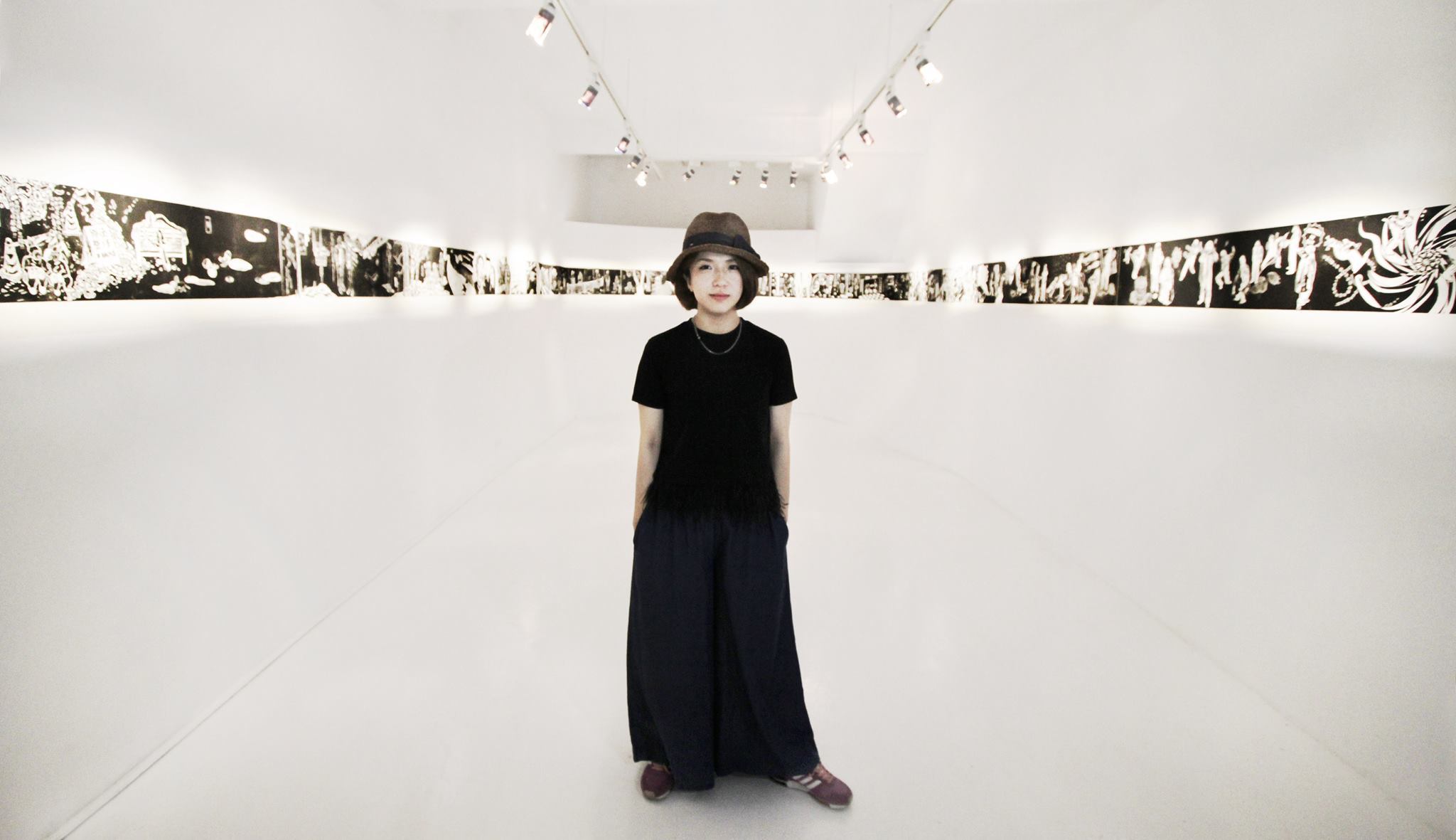
【EDUCATION】
| 2009 | B.F.A. Printmaking, Department of the Fine Arts, TNUA, Taipei, Taiwan |
| 2005 | M.F.A. Printmaking, Graduate School of Plastic Arts, Taipei National University of the Arts (TNUA), Taipei, Taiwan |
【SOLO EXHIBITIONS】
| 2020 |
The Luxuriant Forest, Providence University Art Center, Taichung, Taiwan Breath of SensationⅡ, Hong-gal Museum, Taipei, Taiwan |
| 2019 |
Landscape of Sen-Tai-Wan,Gallery TURNAROUND, Sendai, Japan |
| 2015 |
Traveling Notes, 182 Art Space, Tainan, Taiwan |
| 2013 |
Fashion Fetishism-Huang, Wanling Solo Exhibition, Art Taipei, Taipei, Taiwan Sacrifice-Huang, Wanling Solo Exhibition,H.T. Gallery,Beijing, China |
| 2008 |
Gongyangren , Perhaps Happiness Never Exists…まるで. 回る.Merry-go-round, AKI Gallery, Taipei / ARTHIS Fine Arts, Taichung, Taiwan |
【GROUP EXHIBITIONS】
| 2019 |
Asia Drums, VT Artsalon, Taipei, Taiwan Imagine Picnic, Seongsan Art Hall, Changwon, Korea Asia Contemporary Art Show,Conrad Hotel, Hong Kong Hot Blood, White Rabbit Gallery, Sydney, Australia |
| 2018 |
Ah! Already!, Sam-yuk Building, Seoul, Korea Daegu Art Fair 2018, Daegu EXCO, Daegu, Korea The First Asia-Pacific Art Exhibition, Nanjing University Museum, Nanjing, China Project Island Hopping – Reversing Imperialism: Lander, Jorge B. Vargas Museum and Filipiniana Research Center, Quezon City, Philippines 3nd Taiwan Annual, TAIPEI EXPO PARK EXPO Dome, Taipei, Taiwan Fleeting Landscape, Helios Gallery, Taipei, Taiwan Listen to the thunder at a silent place, Moon Gallery, Taichung,Taiwan Archipelago on an Island, Koganecho Site-A Gallery, Yokohama,Japan Future Theatre, Kuandu Museum Of Arts, Taipei, Taiwan |
| 2017 |
Phiau-phiet ê - Group Exhibition of Taipei ARTISTS, Openspace Bae, Busan, Korea 2nd Taiwan Annual, TAIPEI EXPO PARK EXPO Dome, Taipei, Taiwan 10e Triennale Mondiale de l'Estampe, Chamalières, France Local to Local,ARTFORUM RHEE, Seoul, Korea CROSSOVER , FreeS Art Space, Taipei, Taiwan EXTRAORDINARY-25th Anniversary of Soka Art, Remarkable- Cultivation Museum of Arts, Tainan, Taiwan |
| 2016 |
ART.FAIR | Fair for modern and contemporary art, Koelnmesse Hall 1 and 2, Cologne, Germany 1st Taiwan Annual, TAIPEI EXPO PARK EXPO Dome, Taipei, Taiwan New Taiwan Mural Team- Theather for All, National Taichung Theater, Taichung, Taiwan Dialogue on Printmaking: The Taiwan-US Exchange Exhibition, Taipei Economic and Cultural Office, New York, USA Reunion, TaipeiING, Taipei, Taiwan Shaking, Butchartart International Contemporary Art Space, Taipei, Taiwan |
| 2015 |
Shong Dong International Printmaking Invitational Exhibition, Center of Contemporary art Shong Dong, Nanjing, China Future Flash Fiction,FreeS Art Space, Taipei, Taiwan City museum of art-Voice,Taipei city, Taiwan Artist fair Taiwan, TAIPEI EXPO PARK EXPO Dome, Taipei, Taiwan |
| 2014 |
Shaping Gate Above the Water, Soka Art Center, Tainan, Taiwan Exploring the 80s,0 Gallery, Beijing, China ART OSAKA 2014,Hotel Granvia Osaka, Osaka, Japan YOUNG ART TAIPEI, Regent, Taipei, Taiwan Fallow My Rhythm, Bo Art Gallery, Taipei, Taiwan 2014 Art Tainan, Tayih Landis Hotel ,Tainan, Taiwan Rare Books and Secret Archives:Treasures from the National Palace Museum, National Palace Museum, Taipei, Taiwan |
| 2013 |
2013 Art Kaohsiung, CHATEAU de CHINE,Kaohsiung, Taiwan Zero Plan, Play Zero, Nanhai Gallery, Taipei, Taiwan A Platform for Imagination-A Vision for the Future, Soka Art Center, Tainan, Taiwan Art Taichung 2013,THE SPLENDOR HOTEL, Taichung, Taiwan March residency Open studio, Vermont Studio Center, Vermont, USA |
| 2012 |
Lights of Women , woo jea gill Art Museum, Gwangju, Korea Exploring the 80s,0 Gallery, Beijing, China |
| 2011 |
Asia Plate & Print Exhibition, Kuandu Museum of Arts, Taipei, Taiwan |
| 2010 |
YES TAIWAN-Taiwan Biennial 2010, National Taiwan Museum of Fine Arts, Taichung, Taiwan The 6th Chinese Character Festival - Making Waves Contemporary Art Exhibition, National CKS Memorial Hall, Taipei, Taiwan |
| 2009 |
City Life, Keelung City Cultural Affairs Bureau, Keelung, Taiwan About The Orientation of 21 Century Artists, Kuandu Museum of Arts, Taipei, Taiwan Duel Regard-The Views from Taiwanese Women’s Arts, National Taiwan Museum of Fine Arts, Taichung, Taiwan New Trends: Fifteen Contemporary Chinese Artists, the Pacific Heritage Museum, San Francisco, USA |
| 2008 |
Asian Students and Young Artists Art Festival ( ASYAAF), Old Seoul Station Building, Seoul, Korea Summer Art Exhibition, Ogilvy 0 Gallery, Beijing, China Never Walk Away, Painting’s Lisao, Main Trend Gallery, Taipei, Taiwan |
| 2007 |
The 1st International Contemporary Art Gwangju Artvision , Gwangju Museum of Art, Korea Frolic:Humor and Mischief in New Taiwanese Art, Tenri Gallery, New York, USA 5th Novosibirsk International Biennial of Contemporary Graphic Art, Novosibirsk State Art Museum, Russia All Artists Never Give Up, TNUA, Taipei, Taiwan The Epoch, AKI Gallery, Taipei, Taiwan |
| 2006~2007 |
International Youth Prints Exhibition, Kuandu Museum of Arts, Taipei, Taiwan |
| 2006 |
Prints Anthology, Angel Art Gallery, Taipei, Taiwan The 12th International Biennial Print and Drawing Exhibition, R.O.C., National Taiwan Museum of Fine Arts, Taichung, Taiwan Thirteen Flowers, AKI Gallery, Taipei, Taiwan |
| 2005 |
Reality in Negative Images, TNUA, Taipei, Taiwan |
| 2004 |
Taiwan Avant-garde Documenta Ⅱ:Sale. Art. Exposition, C04, Huashan Culture Park, Taipei, Taiwan In the Mountain Way- TNUA 18th B.F.A. Graduate Exhibition, TNUA, Taipei, Taiwan The 3rd Huashan Artist Fair, Huashan Culture Park, Taipei, Taiwan |
| 2003 |
2003 Crazy Island’s Ritual Part I, Taiwan International Visual Arts Center, Taipei, Taiwan |
| 2001 |
The 1st Huashan Artist Fair, Huashan Culture Park, Taipei, Taiwan |
【COLLECTIONS】
| 2018 |
R301, Room18. Art Studio, Collecting by ARTBANK, Taiwan |
| 2016 |
Traveling Notes No. 5~9, Collecting by ARTBANK, Taiwan |
| 2015 |
Traveling Notes No.1~9, Collecting by White Rabbit Gallery, Sydney, Australia |
| 2014 |
Traveling Notes No.1~4, Collecting by ARTBANK, Taiwan A copy of Poetry-inscribed Papers from the Wenmeizhai Studio, Collecting by National Palace Museum, Taipei, Taiwan |
| 2011 |
Lane.96,Kunming St, Collecting by Kuandu Museum of Arts, Taipei, Taiwan |
| 2007 |
Jeni and me in Hsimending, Collecting by Young Artists’ Works Project, National Taiwan Museum of Fine Arts |
| 2004 |
Old Skateboarder, Ancient-costume Boy, Mongolian Fashion,Green-scarf Arhat, Private Collection of Art Museum @ The Art Park, Shinchu |
【AWARDS】
| 2013 |
Selected by「MADE IN TAIWAN」young artist discovery |
| 2005 |
Selected work, The 12th International Biennial Print and Drawing Exhibition, R.O.C. |
【RESIDENCY】
| 2019 |
KAIKON Art Studio, Japan |
| 2018 |
Seoul Art Space GEUMCHEON, Korea |
| 2017 |
Songgu Monastery,China |
| 2013 |
Vermont Studio Center, USA |
HUANG,WAN-LING
+886935673967
wanling3895@gmail.com
1980 |
Born in Taipei, Taiwan |

【EDUCATION】
| 2009 | B.F.A. Printmaking, Department of the Fine Arts, TNUA, Taipei, Taiwan |
| 2005 | M.F.A. Printmaking, Graduate School of Plastic Arts, Taipei National University of the Arts (TNUA), Taipei, Taiwan |
【SOLO EXHIBITIONS】
| 2020 |
The Luxuriant Forest, Providence University Art Center, Taichung, Taiwan Breath of SensationⅡ, Hong-gal Museum, Taipei, Taiwan |
| 2019 |
Landscape of Sen-Tai-Wan,Gallery TURNAROUND, Sendai, Japan |
| 2015 |
Traveling Notes, 182 Art Space, Tainan, Taiwan |
| 2013 |
Fashion Fetishism-Huang, Wanling Solo Exhibition, Art Taipei, Taipei, Taiwan Sacrifice-Huang, Wanling Solo Exhibition,H.T. Gallery,Beijing, China |
| 2008 |
Gongyangren , Perhaps Happiness Never Exists…まるで. 回る.Merry-go-round, AKI Gallery, Taipei / ARTHIS Fine Arts, Taichung, Taiwan |
【GROUP EXHIBITIONS】
| 2019 |
Asia Drums, VT Artsalon, Taipei, Taiwan Imagine Picnic, Seongsan Art Hall, Changwon, Korea Asia Contemporary Art Show,Conrad Hotel, Hong Kong Hot Blood, White Rabbit Gallery, Sydney, Australia |
| 2018 |
Ah! Already!, Sam-yuk Building, Seoul, Korea Daegu Art Fair 2018, Daegu EXCO, Daegu, Korea The First Asia-Pacific Art Exhibition, Nanjing University Museum, Nanjing, China Project Island Hopping – Reversing Imperialism: Lander, Jorge B. Vargas Museum and Filipiniana Research Center, Quezon City, Philippines 3nd Taiwan Annual, TAIPEI EXPO PARK EXPO Dome, Taipei, Taiwan Fleeting Landscape, Helios Gallery, Taipei, Taiwan Listen to the thunder at a silent place, Moon Gallery, Taichung,Taiwan Archipelago on an Island, Koganecho Site-A Gallery, Yokohama,Japan Future Theatre, Kuandu Museum Of Arts, Taipei, Taiwan |
| 2017 |
Phiau-phiet ê - Group Exhibition of Taipei ARTISTS, Openspace Bae, Busan, Korea 2nd Taiwan Annual, TAIPEI EXPO PARK EXPO Dome, Taipei, Taiwan 10e Triennale Mondiale de l'Estampe, Chamalières, France Local to Local,ARTFORUM RHEE, Seoul, Korea CROSSOVER , FreeS Art Space, Taipei, Taiwan EXTRAORDINARY-25th Anniversary of Soka Art, Remarkable- Cultivation Museum of Arts, Tainan, Taiwan |
| 2016 |
ART.FAIR | Fair for modern and contemporary art, Koelnmesse Hall 1 and 2, Cologne, Germany 1st Taiwan Annual, TAIPEI EXPO PARK EXPO Dome, Taipei, Taiwan New Taiwan Mural Team- Theather for All, National Taichung Theater, Taichung, Taiwan Dialogue on Printmaking: The Taiwan-US Exchange Exhibition, Taipei Economic and Cultural Office, New York, USA Reunion, TaipeiING, Taipei, Taiwan Shaking, Butchartart International Contemporary Art Space, Taipei, Taiwan |
| 2015 |
Shong Dong International Printmaking Invitational Exhibition, Center of Contemporary art Shong Dong, Nanjing, China Future Flash Fiction,FreeS Art Space, Taipei, Taiwan City museum of art-Voice,Taipei city, Taiwan Artist fair Taiwan, TAIPEI EXPO PARK EXPO Dome, Taipei, Taiwan |
| 2014 |
Shaping Gate Above the Water, Soka Art Center, Tainan, Taiwan Exploring the 80s,0 Gallery, Beijing, China ART OSAKA 2014,Hotel Granvia Osaka, Osaka, Japan YOUNG ART TAIPEI, Regent, Taipei, Taiwan Fallow My Rhythm, Bo Art Gallery, Taipei, Taiwan 2014 Art Tainan, Tayih Landis Hotel ,Tainan, Taiwan Rare Books and Secret Archives:Treasures from the National Palace Museum, National Palace Museum, Taipei, Taiwan |
| 2013 |
2013 Art Kaohsiung, CHATEAU de CHINE,Kaohsiung, Taiwan Zero Plan, Play Zero, Nanhai Gallery, Taipei, Taiwan A Platform for Imagination-A Vision for the Future, Soka Art Center, Tainan, Taiwan Art Taichung 2013,THE SPLENDOR HOTEL, Taichung, Taiwan March residency Open studio, Vermont Studio Center, Vermont, USA |
| 2012 |
Lights of Women , woo jea gill Art Museum, Gwangju, Korea Exploring the 80s,0 Gallery, Beijing, China |
| 2011 |
Asia Plate & Print Exhibition, Kuandu Museum of Arts, Taipei, Taiwan |
| 2010 |
YES TAIWAN-Taiwan Biennial 2010, National Taiwan Museum of Fine Arts, Taichung, Taiwan The 6th Chinese Character Festival - Making Waves Contemporary Art Exhibition, National CKS Memorial Hall, Taipei, Taiwan |
| 2009 |
City Life, Keelung City Cultural Affairs Bureau, Keelung, Taiwan About The Orientation of 21 Century Artists, Kuandu Museum of Arts, Taipei, Taiwan Duel Regard-The Views from Taiwanese Women’s Arts, National Taiwan Museum of Fine Arts, Taichung, Taiwan New Trends: Fifteen Contemporary Chinese Artists, the Pacific Heritage Museum, San Francisco, USA |
| 2008 |
Asian Students and Young Artists Art Festival ( ASYAAF), Old Seoul Station Building, Seoul, Korea Summer Art Exhibition, Ogilvy 0 Gallery, Beijing, China Never Walk Away, Painting’s Lisao, Main Trend Gallery, Taipei, Taiwan |
| 2007 |
The 1st International Contemporary Art Gwangju Artvision , Gwangju Museum of Art, Korea Frolic:Humor and Mischief in New Taiwanese Art, Tenri Gallery, New York, USA 5th Novosibirsk International Biennial of Contemporary Graphic Art, Novosibirsk State Art Museum, Russia All Artists Never Give Up, TNUA, Taipei, Taiwan The Epoch, AKI Gallery, Taipei, Taiwan |
| 2006~2007 |
International Youth Prints Exhibition, Kuandu Museum of Arts, Taipei, Taiwan |
| 2006 |
Prints Anthology, Angel Art Gallery, Taipei, Taiwan The 12th International Biennial Print and Drawing Exhibition, R.O.C., National Taiwan Museum of Fine Arts, Taichung, Taiwan Thirteen Flowers, AKI Gallery, Taipei, Taiwan |
| 2005 |
Reality in Negative Images, TNUA, Taipei, Taiwan |
| 2004 |
Taiwan Avant-garde Documenta Ⅱ:Sale. Art. Exposition, C04, Huashan Culture Park, Taipei, Taiwan In the Mountain Way- TNUA 18th B.F.A. Graduate Exhibition, TNUA, Taipei, Taiwan The 3rd Huashan Artist Fair, Huashan Culture Park, Taipei, Taiwan |
| 2003 |
2003 Crazy Island’s Ritual Part I, Taiwan International Visual Arts Center, Taipei, Taiwan |
| 2001 |
The 1st Huashan Artist Fair, Huashan Culture Park, Taipei, Taiwan |
【COLLECTIONS】
| 2018 |
R301, Room18. Art Studio, Collecting by ARTBANK, Taiwan |
| 2016 |
Traveling Notes No. 5~9, Collecting by ARTBANK, Taiwan |
| 2015 |
Traveling Notes No.1~9, Collecting by White Rabbit Gallery, Sydney, Australia |
| 2014 |
Traveling Notes No.1~4, Collecting by ARTBANK, Taiwan A copy of Poetry-inscribed Papers from the Wenmeizhai Studio, Collecting by National Palace Museum, Taipei, Taiwan |
| 2011 |
Lane.96,Kunming St, Collecting by Kuandu Museum of Arts, Taipei, Taiwan |
| 2007 |
Jeni and me in Hsimending, Collecting by Young Artists’ Works Project, National Taiwan Museum of Fine Arts |
| 2004 |
Old Skateboarder, Ancient-costume Boy, Mongolian Fashion,Green-scarf Arhat, Private Collection of Art Museum @ The Art Park, Shinchu |
【AWARDS】
| 2013 |
Selected by「MADE IN TAIWAN」young artist discovery |
| 2005 |
Selected work, The 12th International Biennial Print and Drawing Exhibition, R.O.C. |
【RESIDENCY】
| 2019 |
KAIKON Art Studio, Japan |
| 2018 |
Seoul Art Space GEUMCHEON, Korea |
| 2017 |
Songgu Monastery,China |
| 2013 |
Vermont Studio Center, USA |






